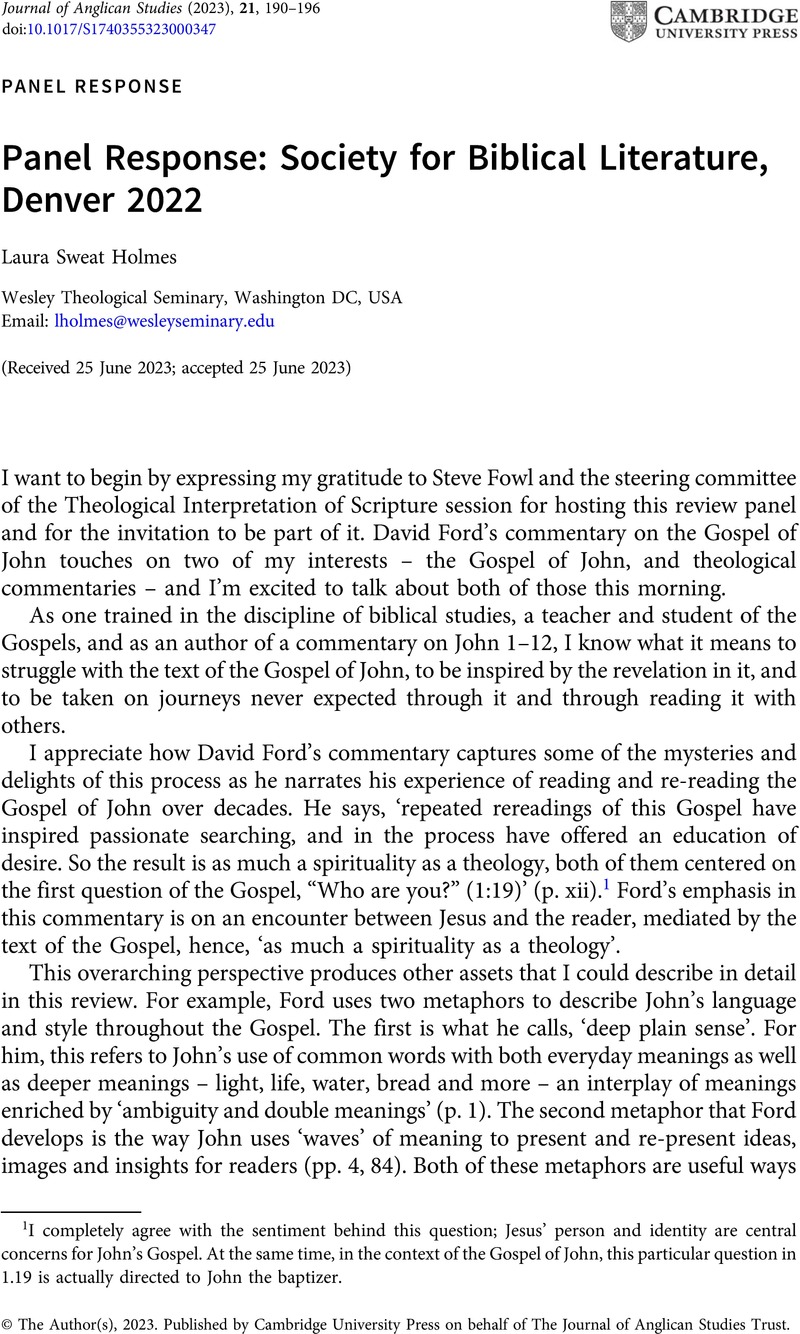No CrossRef data available.
Article contents
Panel Response: Society for Biblical Literature, Denver 2022
Published online by Cambridge University Press: 09 October 2023
Abstract

- Type
- Panel Response
- Information
- Copyright
- © The Author(s), 2023. Published by Cambridge University Press on behalf of The Journal of Anglican Studies Trust
References
1 I completely agree with the sentiment behind this question; Jesus’ person and identity are central concerns for John’s Gospel. At the same time, in the context of the Gospel of John, this particular question in 1.19 is actually directed to John the baptizer.
2 John’s ‘passionate desire is for us, his readers, to encounter the living Jesus to whom he is testifying. This is the main reason he combines pre-resurrection and post-resurrection perspectives: he wants us to understand who Jesus is and that even as we read about what he did and said, we are in the presence of this crucified and risen one who says, “I am,” who loves us incomparably, and who longs above all for us to trust, love, and follow him now’ (p. 9).
3 Definitions compiled from Eckhard J. Schnabel, ‘On Commentary Writing’ (pp. 3-32) and Kevin J. Vanhoozer, ‘Theological Commentary and “The Voice from Heaven”: Exegesis, Ontology, and the Travail of Biblical Interpretation’ (pp. 269-98) both in Stanley E. Porter and Eckhard J. Schnabel (eds.), On the Writing of the New Testament Commentaries: Festschrift for Grant R. Osborne on the Occasion of his 70th Birthday (Texts and Editions for New Testament Study, 8; Leiden: Brill, 2013); and from Brevard S. Childs, ‘The Genre of Biblical Commentary as Problem and Challenge’, in Mordechai Cogan, Jeffrey Tigay and Barry Eichler (eds.), Tehillah le-Moshe: Biblical and Judaic studies in Honor of Moshe Greenberg (Winona Lake, IN: Eisenbrauns, 1997), 185-192.
4 For example, if you look up Jesus’ final words on the cross in Jn 19.30, you would not find any comment about how those words are different than what Jesus says in other gospels. To learn what Ford thinks about that – and you should, it is quite interesting – you have to go back about twelve pages, in his comments on Jn 19.23-25a, which requires you to know that Jn 19.24 quotes Psalm 22 and that the Synoptics also quote Psalm 22. That’s presuming a lot of knowledge of the commentary reader, or simply presuming that the reader will be reading more than isolated sections.
5 This emerges particularly in the context of things like comments on Martha’s confession (Jn 11.27), where Ford says, ‘her (and any other believer’s) understanding of [these titles for Jesus] could no doubt be further enriched, expanded, and deepened, but in John’s terms she has the basic template right’ (p. 221). The problem with this is that the reader needs some information for why Martha’s confession would need this kind of caveat, while Peter’s (Jn 6.69) or Thomas’s (Jn 20.28) would not. The answer could either be a connection to Martha’s later comment about the odor at Lazarus’s tomb (Jn 11.39) or an allusion to Moloney’s argument that does the same (Francis Moloney, ‘Can Everyone Be Wrong? A Reading of John 11:1–12:8’, NTS 49 [2003], pp. 505-27). Without one or both of these, it stands out as an unfortunate and inexplicable jab against Martha.
6 This was quite apparent in his reading of Jesus at the wedding at Cana. Ford summarizes, ‘It is as if our usual concept of the ordinary simply needs to be enlarged to take account of the reality of God and God’s creativity, freedom, and generosity’ (pp. 64-65).
7 This seems to be connected to the idea that John was self-consciously written as Scripture, an idea that could have benefited from explanation and development (p. 27).
8 A similar process happens with John 10, though there the imagery is that of shepherd/sheep and not of lamb, specifically (p. 210).





